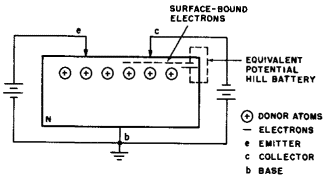| Transistor Basics is a free introductory textbook on transistors and their basic applications. See the editorial for more information.... |

|

Home  Transistors and Their Operation Transistors and Their Operation  Point-Contact Transistors Point-Contact Transistors  Surface-Bound Electrons Surface-Bound Electrons |
||






|
||
|
Surface-Bound ElectronsAuthor: Leonard Krugman
Fig. 2-2. Basic point-contact transistor operation. The proper battery connections for a transistor can be determined as follows: The emitter is always biased in the forward or low resistance direction. Since this is accomplished by reducing the potential hill, the positive battery terminal is connected to the emitter. Conversely, the collector is always biased in the reverse, or high-resistance, direction. Therefore, the negative battery terminal is connected to the collector in order to increase the potential hill.
|
||
Home  Transistors and Their Operation Transistors and Their Operation  Point-Contact Transistors Point-Contact Transistors  Surface-Bound Electrons Surface-Bound Electrons |
||
Last Update: 2010-11-17


